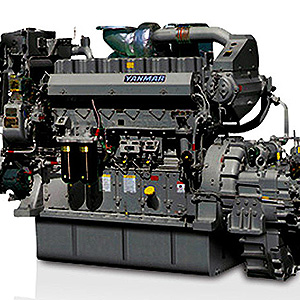Uses and Functions of Yanmar Propulsion Engines
Blog | December 15th, 2016

If we were to say that Yanmar propulsion engines are built to the highest engineering standards, the truth of this statement would ring out long and loud across the seagoing lanes. But what do we get for that premiere build? What’s the payoff here? Well, this brawny prime mover family is faithfully designed to accommodate any commercial shipping application, all the way up to the heaviest freighters in the business.
A Whale of an Engine
Before talking about top-notch features, let’s define the primary function. Yanmar propulsion engines are designed to thrust large marine frames across the water. Resolute in purpose, stellar in design, the medium speed range is every bit as meticulously designed as the high-speed series, except that medium velocity group has been gifted with more muscle. In point of fact, the 368 kw base model (6RY17W) provides enough propulsion energy to send a small pleasure craft sailing smoothly out of its moorings, but the 3310 kw powerhouse (8N330-EW) ups the game by providing fluid momentum for large commercial ships and compact workboats.
Fishing for Power
A fixed pitch propeller (FPP) design equips small fishing boats and larger trawlers with a diesel engine that liberates coasting force. That medium power rating adapts to match high seas and flat waters, yet its fuel economical components never skip a beat. Equally at home on a yacht, the reliable Yanmar brand also carries passengers into deep waters, areas where dependability means more than velocity. Still, that reliability factor doesn’t mean the controls can’t be set for “full-ahead” whenever the fishing craft’s helmsman needs a speed boost.
Empowering Commercial Applications
Diesel engines at sea are famed for their ability to scale. Larger motion-driving mechanisms propel river ferries and larger island ferries back and forth all day long. Meanwhile, factory trawlers use the primary power and any supplementary energy to thrust a working vessel forward while some of that same drive energy mobilizes a hydraulics line and other supplementary systems. At its heart, the engine is rotating a fixed pitch or controllable pitch propeller, but there’s enough overhead left in the system for a few fluid-based workstations.
The overhead goes to tools and cleaning hoses. Meanwhile, the rotating shaft delivers rotor energy for a generator, with its accompanying stator sending electromagnetically induced current straight to a power distribution board. Nothing goes to waste as the medium-speed and high-speed Yanmar propulsion engines use their 6 and 8 cylinder blocks to push large and small craft beyond their cruise speed with fuel-economical diesel energy.
Optimized by NetwizardSEO.com.au
Recent Posts
- Turbochargers Supply from Japan Marine: Wildon Engineering’s Excellence in Global Shipping
- Mitsubishi VOS Ballast Water Treatment System: Next-Generation Marine Environmental Solutions
- Yanmar Marine Compressors: Reliable Power Systems for Commercial Vessels
- Water-Lubricated Stern Tube Bearings Explained: How EVR Technology Supports Marine Propulsion
- YANMAR Auxiliary Generator Engine Parts for Commercial Vessels
- Fluid Control Systems: Innovations in Marine Applications
- Yanmar Diesel Generators Australian Distributor: Power for Shipping & Marine Operations
- Navigation & Communication Equipment: Essential Tools for Safe Voyages
- Stern Tube Seals: Preventing Leaks & Maintaining Vessel Integrity
- Innovative Cathodic Protection Technologies for Maritime Industries
